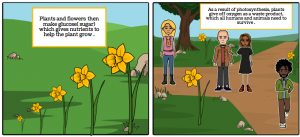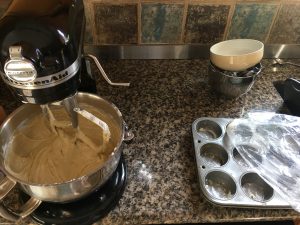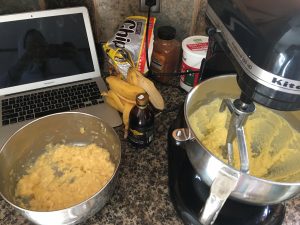This is a Dove body wash ad. When an ad is showing woman in their bras and underwear or swimsuits they usually have a mannequin like body, but this ad is different. They have short woman , tall woman, thin woman, plus size woman , woman with light skin and woman with dark skin. This is a body positive ad that shows diversity.
Photosynthesis Comic Strip
Value/Friendship ComicStrip
Ponderrosa Cupcake foods 11 lab
Darwins Blog Post
How did the discovery of DNA prove that Darwin’s theory of evolution was correct and how does it change the way we view evolution today and into the future?
Darwin’s theory of Natural Selection: that all living things on earth shared a common ancestor. This theory was thought of as bizarre at first, but with later research seen to be true. After studying the DNA of apes, it was seen that human beings and apes were carrying many of the same traits. “Common traits” were seen through many other species as well.
Now and Then
Reflection:
- Many things are the same, just now in the 2010’s, we have more developed and evolved more.
- People now a days are more health conscious now a days.
- A privilege I have today that my aunt did not back in the 80’s is that I am able to have parents who give me freedom of speech and I have parents who understand adolescence more. Back in the day I feel like parents were seen as “elders” and teens weren’t able to have arguments and debates with their parents. Now I feel like parents and their children are closer.
- I don’t think adolescence in the 80’s have any privileges or rights that adolescence today don’t have. I think this is because people are smarter with how they raise their children and teens push their parents boundaries more and end up getting away withmore.
- I would 100% rather have grown up in the 50’s 60’s 70’s or 80’s. I feel like it was a more simpler time. I don’t like how technology rules the world now a days and how people interact together. I would love it if we could have a combination of both the 80’s and 2010’s. Some aspects of the 2010’s are great! I love how health conscious we have become and how we are more aware of our surrounding and how we must take care of the planet we live on.
What Darwin never knew
How did the discovery of DNA prove that Darwin’s theory of evolution was correct and how does it change the way we view evolution today and into the future?
Document Gallery
The Six Kingdoms
Top 5 Math 10 blog post
Math has been a fun yet challenging class for me this year. I was able to grasp more mathematic vocabulary this year and also further my skills from last year. This post is going to be an array of the top 5 things I learned in Precalculus math 10.
1.) Factoring polynomials
When factoring polynomials, we determine all terms that were multiplied together to get the given polynomial. Let’s say we have this polynomial equation that needs to be factored.
Now as you can see, I took the X squared and I broke it down into two equations each one containing an X. I then figured out what multiplied by what equals to 16. Now although 8 multiple by 2 equals 16, the two smallest number that can multiply to 16 is 4. Of course make sure the equation has one positive 4 and one negative 4 so that the answer will equal -16.
Now we have X to the 4th . To factor this kind of equation we must go through one extra step. We now break the equation into 3 brackets, leaving the first bracket with X squared and the other two with one X each. Now we want to multiply out so we take 4,2 and -2. We now have a factored polynomial equation.
2.) Entire radicals into mixed radicals
We are going to start out my factoring the entire radicals number. In this case the number is 63 and when we factor 63 out we get 7 multiplied by 9, and then we are able to break 9 down into 3 multiplied by 3. From there we put the prime numbers into where the 63 was. We then find any common pairs. In this equation we have two three’s so these are pulled into the coefficient stop of the radical. and the seven is left inside. We now have 3 root 7.
3.) GCF and LCM
Although these seem like very basic and simple math skills, I was able to master them and be able to find either of them quickly and efficiently. When dealing with finding the GCF(Greatest common factor) of a two different numbers we must factor out the smallest numbers that multiply to that number.
Now when fiddling the LCM (Lowest common factor) of two numbers you multiply each number out until you find one that they multiply to. For example 6 and 3’s LCM would be 6 because that is the smallest number that they both multiply to. 
4.) All about numbers and number vocabulary
Numbers come in many different forms. In out first chapter, we learned about all the different kinds that we would be dealing with throughout the course. We learned about 8 different kinds of numbers in math 10. We also learned that numbers can be grouped by their decimal representation. The 8 different kinds of numbers we came across were:
R= Real numbers are all numbers
Q= Rational numbers are numbers that can be made by dividing two integers
Q (with a line on top) = Irrational numbers are real numbers that can NOT be made by dividing two numbers.
Terminating numbers = rational numbers in decimal form that have a finite number of digits. (7.3)
Repeating numbers = 5.121212 a number with a decimal that repeats itself
Integer numbers = Whole numbers not including zero and can be positive or negative
Whole numbers = Only positive numbers with no decimals (10)
Natural numbers = The numbers that came naturally to you, the numbers your parents taught you as a baby. No zero (1,2,3,4,5,6,7,8,9,10)
5.) Trigonometry
Trigonometry helps us find angles and distances and it is a way of measuring. A right triangle is divided into 3 sides. The hypotenuse, opposite and the adjacent. The adjacent is located by the refuse angle, the opposite is opposite to the reference angle and the hypotenuse is the longest side. Nicknames for these sides are hyp, opp and adj. To find angles we use three main functions. The functions we used are Sine, Cosine and Tangent. To find any angle we use SOH CAH TOA . SOH CAH TOA stands for:
Here is an example of using Sine to find an angle.


































